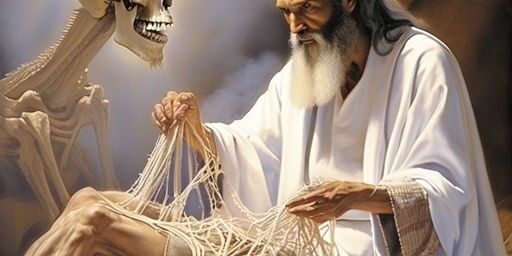From The Rabbi’s Study…Shabbat, April 26, 2024/18 and 19 Nisan 5784
Torah: Acharei Mot (Leviticus 16:1-18:30)
Haftarah and Maftir for the Intermediate Sabbath of Passover:
(Exodus 23:12-34:26;Eziekel 37:1-14)
When kindling the Shabbat candles, recite the prayer and add V’ Yom Tov because it is still Passover. The Hamotzi will be recited using 2 Matzot. Yizkor is recited on the 8th day of Passover. Kindle the Yizkor candle the night before, which will be on Monday, April 29, and Tuesday morning recite Yizkor* If you do not have the service, recite the Mourner’s Kaddish.
A huge Todah Rabah (Thank you very much) to all the people that made our Community Seder a Spiritual and Successful moment for everyone. Chag Pesach!
The Torah portion begins by recalling the deaths of Aaron’s two sons, Nadav and Avihu. Then the descriptions of the rituals for the sin offerings that Aaron is to present in the sanctuary for himself and the people. There are laws regarding sexual relations.
This Torah portion tells about the scapegoat. Aaron is standing at the entrance of the sanctuary with two male goats. He is going to mark one of the goats “for G-d” and the other “for Azazel” as the scapegoat for the mistakes and errors the people committed. When this ritual is completed, Aaron places his hand on the goat marked “for Azazel” and confesses all the wrong doing of the people. The goat is then released into the wilderness.
There are many interpretations of this ritual. References to Esau and Jacob. Esau as the hunter in the wilderness and Jacob ‘s life was marked “for G-d.” While Maimonides states that the scapegoat is an allegory meant for the people that sinned will inevitably lead them to a wasteland.
The Maftir reading (concluding aaliyah before the Haftarah reading, which will conclude the Torah portion of the Sabbath service) is about the time after the golden calf, and Moses shattering the first set of the tablets. Moses reascends the Mount Sinai to receive the new set of tablets. Moses pleads for G-d’s assurance of support. G-d reassures Moses, and reveals His thirteen divine attributes. Then Moses goes down the mountain with the new set of the Ten Commandments.
The Haftarah is taken from the Book of Ezekiel. The prophet was in the valley of dry bones. The prophet Ezekiel views G-d’s spirit knitting the bones together and covering them with flesh. Ezekiel comprehends this vision meaning as that of the people of Israel that are in exile in Babylon, will again be reborn as a nation.
Passover recalls past deliverances, looking to the future redemption, and an old tradition that the resurrection of the dead will take place during the time of Passover, and these passages are chosen for the Intermediate Sabbath of Passover.
Today, we are seeing the increase of Anti-Semitism on campuses and in cities around the world. I would like to drash on something Elie Wiesel wrote:
Pesach is central and a collective memory for the Jewish people.
Elie Wiesel wrote,
“ Without memory, there is no culture.
Without memory, there will be no civilization, no society, no future.”
As Jews we have Communal memory of Mount Sinai, The Holocaust and the relationship of the individual’s personal memory. May we all stand together as one people and ONE NATION during these horrific dark times.
Hazak, Hazak, v’Nitzhazak! Strength, Strength, and together we are STRONGER!
Never Be Silent, and NEVER FORGET!
Shabbat Shalom v’Yom Tom,
AM YSRAEL CHAI! LONG LIVE ISRAEL! It is now over 200 Days of the Hostages being held, May HaShem bring them freedom and return them home,
Rabbi Hene Ainbinder







